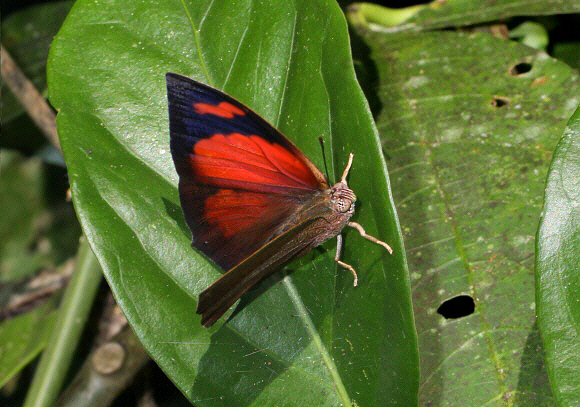 Fountainea ryphea ecuadorialis, Satipo, Peru – Adrian Hoskins
Fountainea ryphea ecuadorialis, Satipo, Peru – Adrian Hoskins
Introduction
The tribe Anaeini comprises of 87 neotropical species in the genera Coenophlebia, Consul, Anaea, Polygrapha, Memphis, Siderone, Fountainea and Zaretis. The butterflies are characterised by having a very rapid and strong flight. They have stout bodies, falcate wings, and on the upper surface are generally black, marked with bands of orange, bright red, or lustrous blue according to species. The undersides of all species in the Anaeini are cryptically patterned and bear a strong resemblance to the dead leaves, tree bark or boulders on which they settle.
The genus Fountainea comprises of 8 species, most of which are widely distributed throughout the neotropical region. The hindwings of most species have short tails, in both sexes, although in the males of ryphea and sosippus these are vestigial or absent.
In some races of Fountainea ryphea the males have a beautiful purple sheen across the wings, but this can only be seen from certain angles.This species occurs in Mexico, Guatemala, Belize, Costa Rica, Panama, Venezuela, Trinidad, Colombia, Guyana, Surinam, Ecuador, Brazil, Peru and Bolivia.
Habitats
This species is usually encountered in secondary / disturbed forest habitats e.g. along wide trails, riverbanks and close to habitations. It is found in both deciduous and evergreen forests at altitudes between sea level and about 1000m.
Lifecycle
The eggs are white, and laid singly on the foliage of the foodplants.
The fully grown larva is green, with paler longitudinal lines along the back, and lightly marbled with reddish brown and white along the sides. It has a large head that is adorned with a pair of short horns. The larva lives within a cell made by rolling up a leaf and securing it with fine silk. It feeds on saplings of Croton – a tree in the Euphorbiaceae.
The chrysalis is suspended by the cremaster from a stem or leaf. It is pale greenish, with the wing cases edged in pale yellow. The head and thorax form a barrel shaped section, and the abdominal segments are highly compressed, forming a short cone.
Adult behaviour
The butterflies are usually seen singly, often as the sole Fountainea species amidst a mixed group of Memphis, Doxocopa and Taygetis species that have aggregated to feed at dung or rotting fruit on the forest floor. Males also visit sewage seepages and river beaches to imbibe mineralised water.
The flight and general behaviour is similar to that of other Charaxine genera. They tend to remain settled on foliage or on the ground for long periods. If disturbed they fly up, circle around briefly, and then settle on the foliage of a nearby tree. After a while, they descend cautiously over a period of several minutes, in a series of steps, often settling on leaves that are in dappled sunlight. At such times they often bask with wings half open. Eventually they return to ground level, and sometimes flit about, fanning their wings for a few moments, before closing them. Once settled with wings closed they are confident in the disguise afforded by their “dead-leaf” undersides, and will remain stationary for many minutes.
